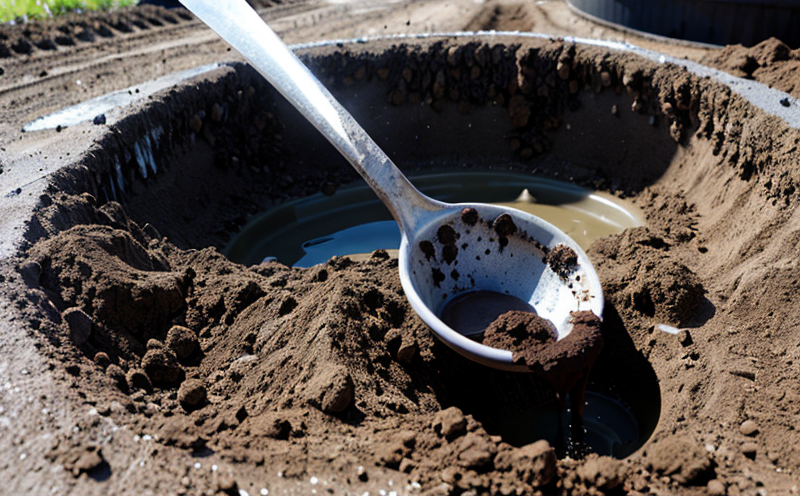EPA 533 Short Chain PFAS in Sludge Test
The EPA Method 533 is a widely recognized analytical protocol for measuring short-chain per- and polyfluoroalkyl substances (PFAS) in sludge. This method has been specifically designed to address the growing concern regarding PFAS contamination, which can originate from industrial processes, firefighting foam use, and wastewater treatment systems. Short-chain PFAS, such as PFOA and PFOS, are of particular interest due to their persistence in the environment and potential adverse health effects.
In this test, sludge samples undergo rigorous analysis using a combination of sample preparation techniques followed by high-performance liquid chromatography (HPLC) with mass spectrometry detection (MS/MS). The method is stringent and ensures accurate quantification of PFAS concentrations in compliance with regulatory standards. This service is essential for quality managers, compliance officers, R&D engineers, and procurement personnel involved in managing or treating sludge and biosolids.
The EPA 533 test protocol is particularly relevant for facilities dealing with municipal wastewater treatment plants (WWTPs), industrial waste management operations, and environmental remediation projects. By ensuring that short-chain PFAS levels are within acceptable limits, these organizations can safeguard public health and protect the environment from potential contamination.
The methodology involves several critical steps:
- Sample collection: Careful sampling of sludge is crucial to ensure representative samples for analysis.
- Solvent extraction: The extracted PFAS components are then cleaned up using a solid-phase extraction (SPE) procedure.
- HPLC-MS/MS analysis: This sophisticated analytical technique allows for accurate detection and quantification of short-chain PFAS in sludge samples.
The results from this test provide valuable insights into the presence, concentration, and potential risks associated with PFAS compounds. These data are indispensable for making informed decisions regarding waste management practices, compliance reporting, and risk assessment. By leveraging EPA Method 533, clients can ensure that their operations adhere to stringent environmental regulations and contribute to sustainable practices.
Applied Standards:
| Standard | Description |
|---|---|
| EPA Method 533 | Analytical procedure for measuring short-chain PFAS in sludge. |
| ISO/IEC 17025 | Affirms the competence of the laboratory to perform specific tests and provide services. |
This table highlights the key standards that govern this testing procedure, ensuring accuracy and reliability in our results. By adhering to these rigorous protocols, we can offer clients a comprehensive understanding of their sludge samples' PFAS content.
Applied Standards
| Standard | Description |
|---|---|
| EPA Method 533 | Analytical procedure for measuring short-chain PFAS in sludge. |
| ISO/IEC 17025 | Affirms the competence of the laboratory to perform specific tests and provide services. |
The EPA Method 533 is central to our testing protocol for short-chain PFAS in sludge. This method ensures accurate measurement of PFAS levels, which are critical for regulatory compliance and environmental protection. Additionally, adherence to ISO/IEC 17025 standards guarantees that our laboratory maintains the highest level of proficiency and credibility.
Benefits
The EPA 533 short-chain PFAS test offers numerous benefits for clients involved in sludge management. Firstly, it ensures accurate measurement of PFAS levels, which is essential for compliance with environmental regulations. Secondly, the data obtained from this test can inform risk assessment and help identify potential sources of contamination within wastewater treatment processes.
By using EPA Method 533, our laboratory provides clients with reliable results that can be used to make informed decisions about waste management practices. This information is invaluable for quality managers and compliance officers who need to ensure that their operations are environmentally responsible and meet regulatory requirements.
The test also supports the development of sustainable practices within sludge and biosolids management. By identifying PFAS levels, clients can take proactive measures to mitigate risks and protect public health. Furthermore, this service enhances the transparency and credibility of environmental reporting, which is crucial for maintaining a positive reputation in the industry.
Why Choose This Test
- Precision: EPA Method 533 ensures accurate measurement of short-chain PFAS levels.
- Regulatory Compliance: The test supports compliance with environmental regulations.
- Risk Assessment: Identifies potential sources of PFAS contamination within wastewater treatment processes.
- Sustainable Practices: Supports the development of sustainable waste management practices.
- Transparency and Credibility: Enhances the transparency and credibility of environmental reporting.
The EPA 533 short-chain PFAS test is an indispensable tool for managing sludge and biosolids effectively. By choosing this service, clients can ensure that their operations are environmentally responsible and meet regulatory requirements. The precision and reliability of our results provide valuable insights into the presence of PFAS in sludge samples, enabling proactive measures to mitigate risks.





